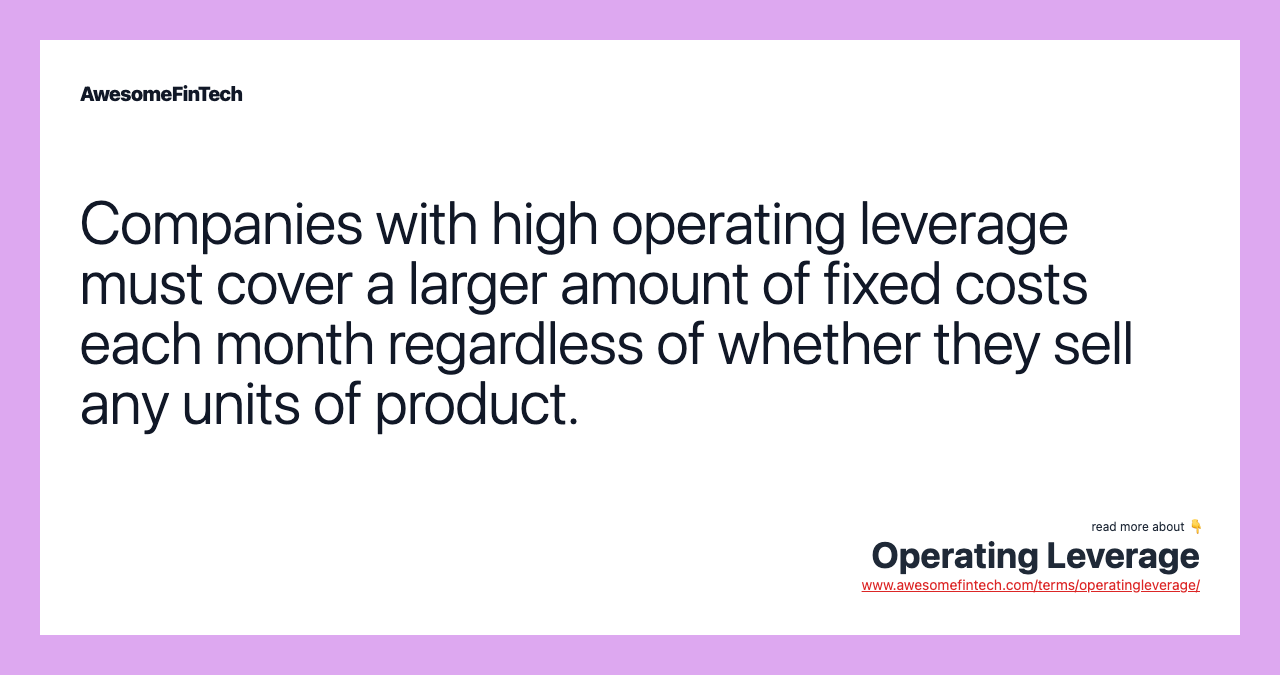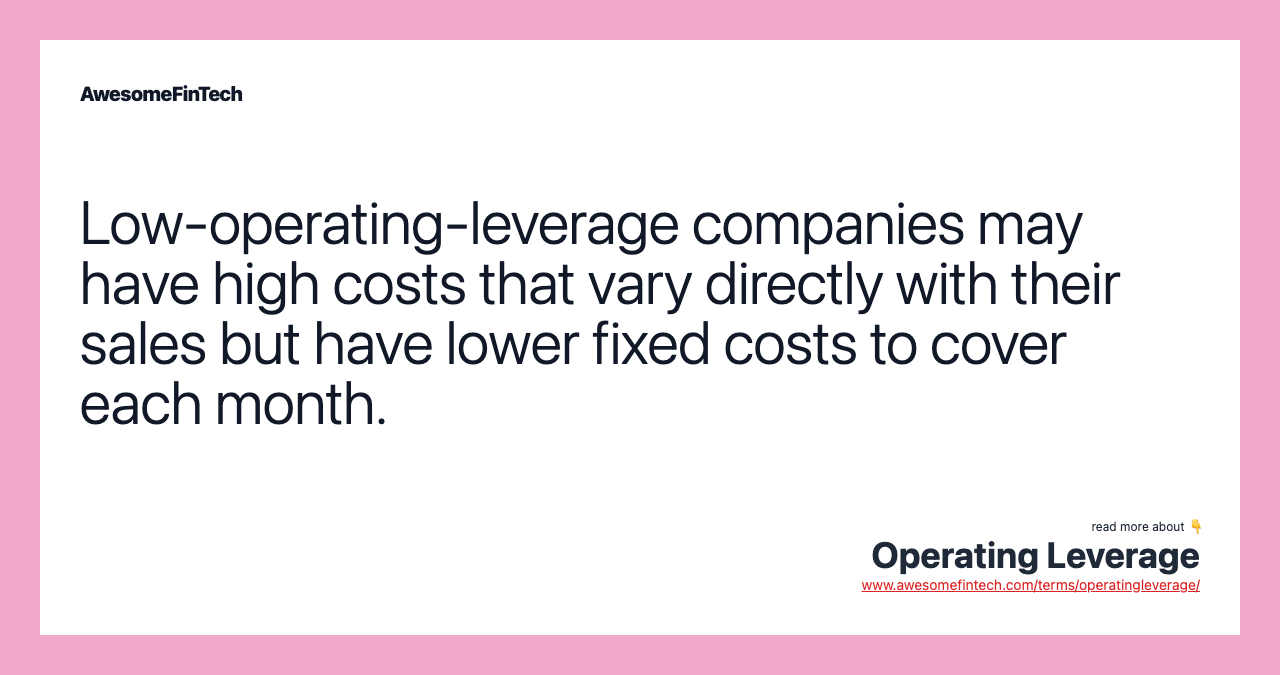Operating Leverage
Operating leverage is a cost-accounting formula that measures the degree to which a firm or project can increase operating income by increasing revenue. The higher the degree of operating leverage, the greater the potential danger from forecasting risk, in which a relatively small error in forecasting sales can be magnified into large errors in cash flow projections. Degree of operating leverage \= Contribution margin Profit \\text{Degree of operating leverage} = \\frac{\\text{Contribution margin}}{\\text{Profit}} Degree of operating leverage\=ProfitContribution margin This can be restated as: Degree of operating leverage \= Q ∗ C M Q ∗ C M − Fixed operating costs where: Q \= unit quantity C M \= contribution margin (price - variable cost per unit) \\begin{aligned} &\\text{Degree of operating leverage} = \\frac{Q\*CM}{Q\*CM - \\text{Fixed operating costs}}\\\\ &\\textbf{where:}\\\\ &Q = \\text{unit quantity}\\\\ &CM = \\text{contribution margin (price - variable cost per unit)}\\\\ \\end{aligned} Degree of operating leverage\=Q∗CM−Fixed operating costsQ∗CMwhere:Q\=unit quantityCM\=contribution margin (price - variable cost per unit) The operating leverage formula is used to calculate a company’s break-even point and help set appropriate selling prices to cover all costs and generate a profit. Companies with a large proportion of fixed costs (or costs that don't change with production) to variable costs (costs that change with production volume) have higher levels of operating leverage. Low-operating-leverage companies may have high costs that vary directly with their sales but have lower fixed costs to cover each month. One conclusion companies can learn from examining operating leverage is that firms that minimize fixed costs can increase their profits without making any changes to the selling price, contribution margin, or the number of units they sell.

What Is Operating Leverage?
Operating leverage is a cost-accounting formula that measures the degree to which a firm or project can increase operating income by increasing revenue. A business that generates sales with a high gross margin and low variable costs has high operating leverage.



Understanding Operating Leverage
The higher the degree of operating leverage, the greater the potential danger from forecasting risk, in which a relatively small error in forecasting sales can be magnified into large errors in cash flow projections.
The Operating Leverage Formula Is:
Degree of operating leverage = Contribution margin Profit \text{Degree of operating leverage} = \frac{\text{Contribution margin}}{\text{Profit}} Degree of operating leverage=ProfitContribution margin
This can be restated as:
Degree of operating leverage = Q ∗ C M Q ∗ C M − Fixed operating costs where: Q = unit quantity C M = contribution margin (price - variable cost per unit) \begin{aligned} &\text{Degree of operating leverage} = \frac{Q*CM}{Q*CM - \text{Fixed operating costs}}\\ &\textbf{where:}\\ &Q = \text{unit quantity}\\ &CM = \text{contribution margin (price - variable cost per unit)}\\ \end{aligned} Degree of operating leverage=Q∗CM−Fixed operating costsQ∗CMwhere:Q=unit quantityCM=contribution margin (price - variable cost per unit)
The operating leverage formula is used to calculate a company’s break-even point and help set appropriate selling prices to cover all costs and generate a profit. The formula can reveal how well a company is using its fixed-cost items, such as its warehouse and machinery and equipment, to generate profits. The more profit a company can squeeze out of the same amount of fixed assets, the higher its operating leverage.
One conclusion companies can learn from examining operating leverage is that firms that minimize fixed costs can increase their profits without making any changes to the selling price, contribution margin, or the number of units they sell.
For example, Company A sells 500,000 products for a unit price of $6 each. The company’s fixed costs are $800,000. It costs $0.05 in variable costs per unit to make each product.
Calculate company A’s degree of operating leverage as follows:
500 , 000 ∗ ( $ 6.00 − $ 0.05 ) 500 , 000 ∗ ( $ 6.00 − $ 0.05 ) − $ 800 , 000 = $ 2 , 975 , 000 $ 2 , 175 , 000 = 1.37 or 137 % . \begin{aligned} &\frac{500,000*\left(\$6.00 - \$0.05 \right )}{500,000*\left(\$6.00 - \$0.05 \right )-\$800,000}\\ &=\frac{\$2,975,000}{\$2,175,000}\\ &=1.37 \text{ or } 137\%. \end{aligned} 500,000∗($6.00−$0.05)−$800,000500,000∗($6.00−$0.05)=$2,175,000$2,975,000=1.37 or 137%.
A 10% revenue increase should result in a 13.7% increase in operating income (10% x 1.37 = 13.7%).
High and Low Operating Leverage
It is important to compare operating leverage between companies in the same industry, as some industries have higher fixed costs than others. The concept of a high or low ratio is then more clearly defined.
Most of a company’s costs are fixed costs that recur each month, such as rent, regardless of sales volume. As long as a business earns a substantial profit on each sale and sustains adequate sales volume, fixed costs are covered and profits are earned.
Other company costs are variable costs that are only incurred when sales occur. This includes labor to assemble products and the cost of raw materials used to make products. Some companies earn less profit on each sale but can have a lower sales volume and still generate enough to cover fixed costs.
For example, a software business has greater fixed costs in developers’ salaries and lower variable costs in software sales. As such, the business has high operating leverage. In contrast, a computer consulting firm charges its clients hourly and doesn't need expensive office space because its consultants work in clients' offices. This results in variable consultant wages and low fixed operating costs. The business thus has low operating leverage.
Most of Microsoft’s costs are fixed, such as expenses for upfront development and marketing. With each dollar in sales earned beyond the break-even point, the company makes a profit, but Microsoft has high operating leverage.
Conversely, Walmart retail stores have low fixed costs and large variable costs, especially for merchandise. Because Walmart sells a huge volume of items and pays upfront for each unit it sells, its cost of goods sold increases as sales increase. Because of this, Walmart stores have low operating leverage.
What Does Operating Leverage Tell You?
The operating leverage formula is used to calculate a company’s break-even point and help set appropriate selling prices to cover all costs and generate a profit. This can reveal how well a company is using its fixed-cost items, such as its warehouse and machinery and equipment, to generate profits. The more profit a company can squeeze out of the same amount of fixed assets, the higher its operating leverage.
One conclusion companies can learn from examining operating leverage is that firms that minimize fixed costs can increase their profits without making any changes to the selling price, contribution margin, or the number of units they sell.
What Is the Degree of Operating Leverage (DOL)?
The degree of operating leverage (DOL) is a multiple that measures how much the operating income of a company will change in response to a change in sales. Companies with a large proportion of fixed costs (or costs that don't change with production) to variable costs (costs that change with production volume) have higher levels of operating leverage. The DOL ratio assists analysts in determining the impact of any change in sales on company earnings or profit.
What Are Examples of High and Low Operating Leverage?
Companies with high fixed costs tend to have high operating leverage, such as those with a great deal of research & development and marketing. With each dollar in sales earned beyond the break-even point, the company makes a profit. Conversely, retail stores tend to have low fixed costs and large variable costs, especially for merchandise. Because retailers sell a large volume of items and pay upfront for each unit sold, COGS increases as sales increase. Because of this, such stores often have low operating leverage.
Related terms:
Breakeven Point (BEP)
In accounting and business, the breakeven point (BEP) is the production level at which total revenues equal total expenses. read more
Cost-Volume-Profit (CVP) Analysis
Cost-volume-profit (CVP) analysis looks at the impact that varying levels of sales and product costs have on operating profit. read more
Degree of Operating Leverage (DOL)
The degree of operating leverage is a multiple that measures how much operating income will change in response to a change in sales. read more
Financial Institution (FI)
A financial institution is a company that focuses on dealing with financial transactions, such as investments, loans, and deposits. read more
Gross Margin
The gross margin represents the amount of total sales revenue that the company retains after incurring the direct costs (COGS) associated with producing the goods and services sold by the company. read more
Liquidity Ratio
Liquidity ratios are a class of financial metrics used to determine a debtor's ability to pay off current debt obligations without raising external capital. read more
Operating Margin
The operating margin measures the profit a company makes on a dollar of sales after accounting for the direct costs involved in earning those revenues. read more
Variable Cost
A variable cost is an expense that changes in proportion to production or sales volume. read more